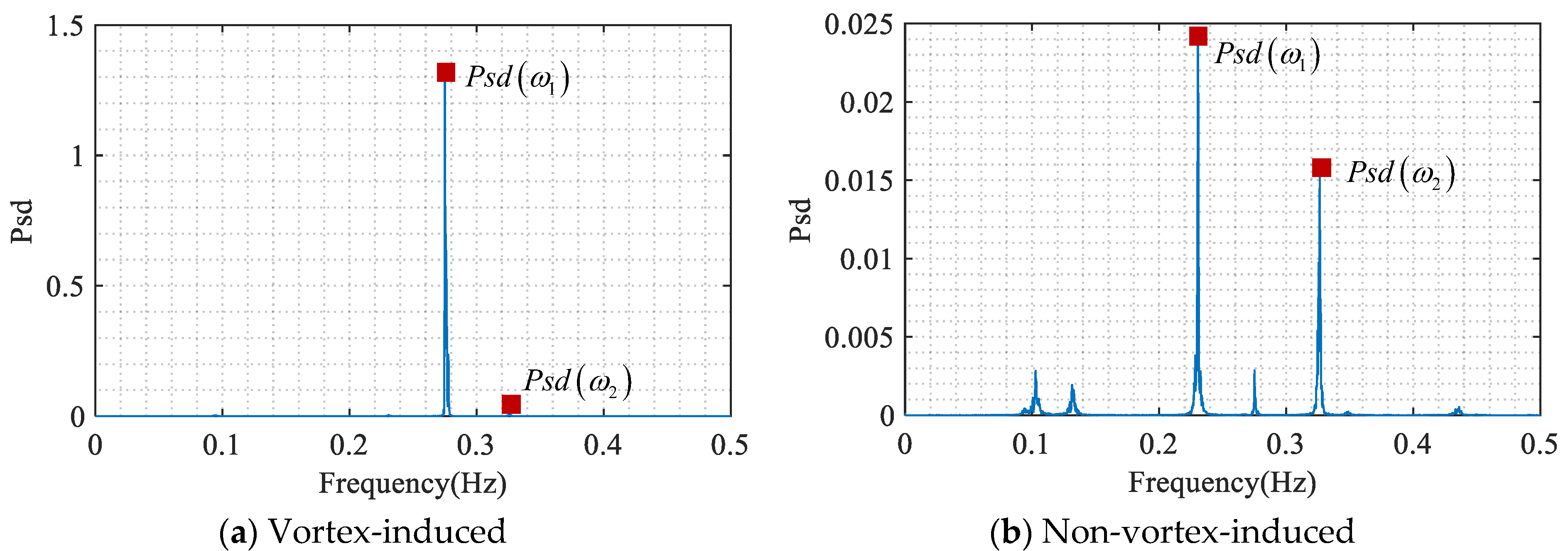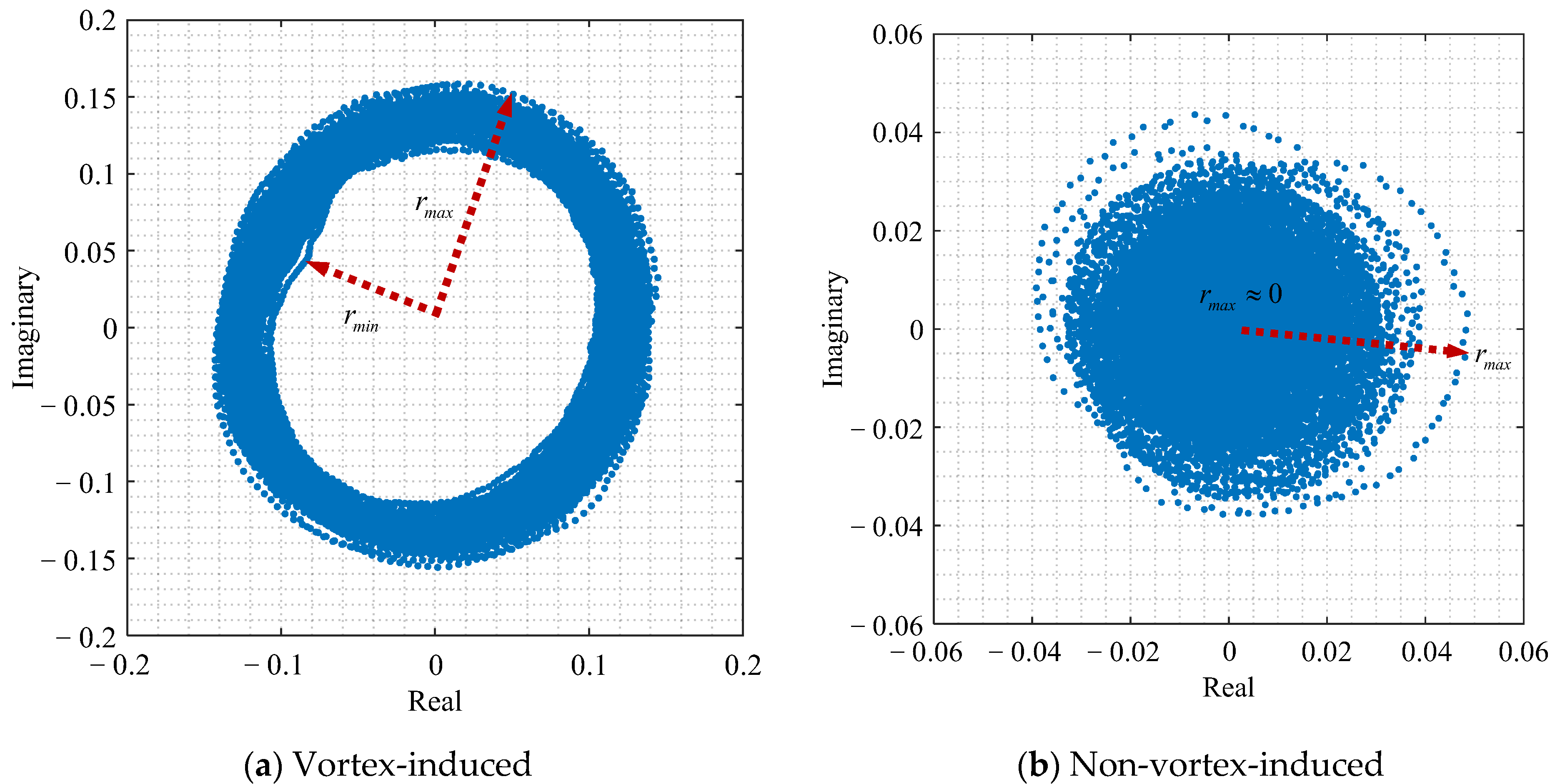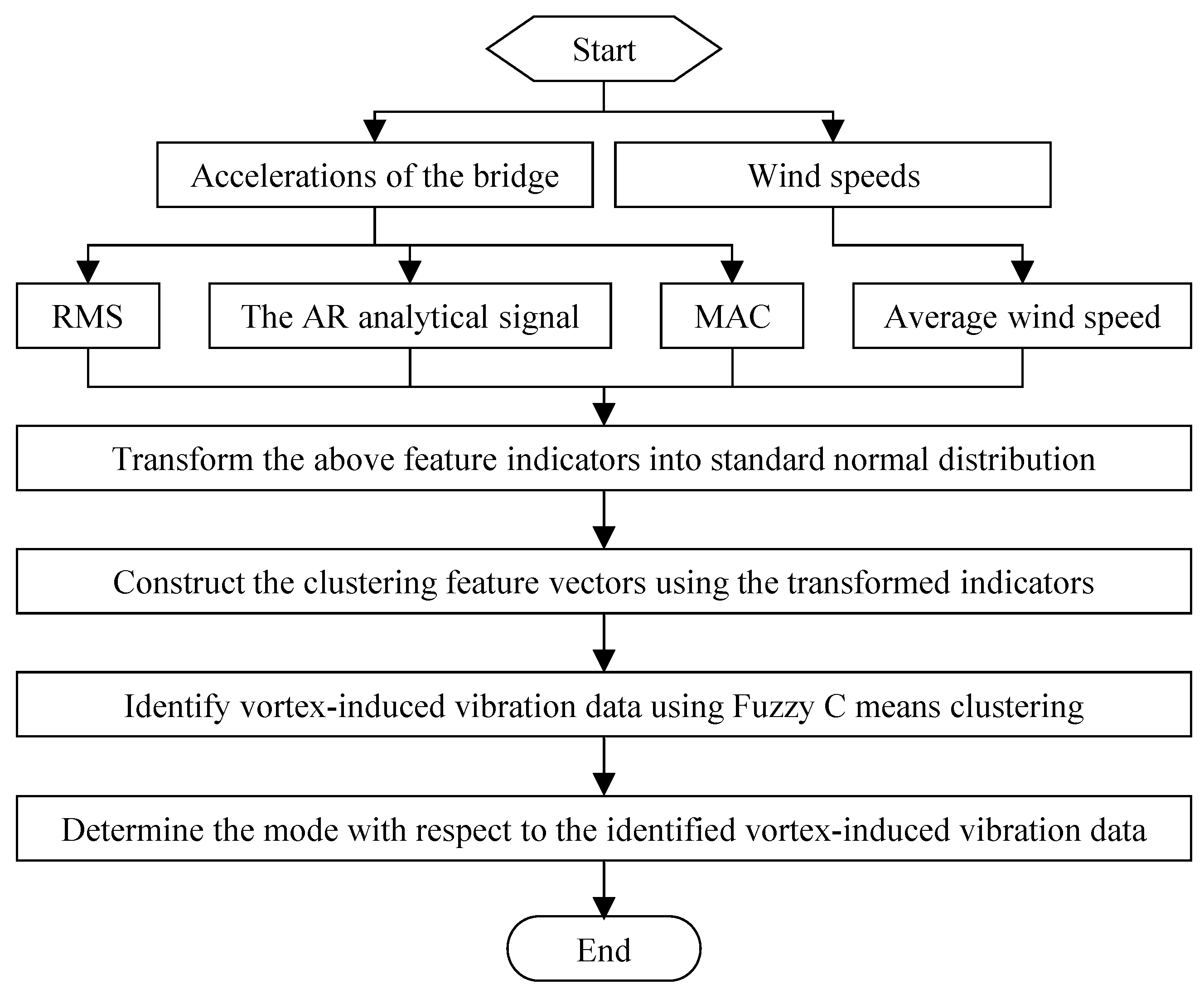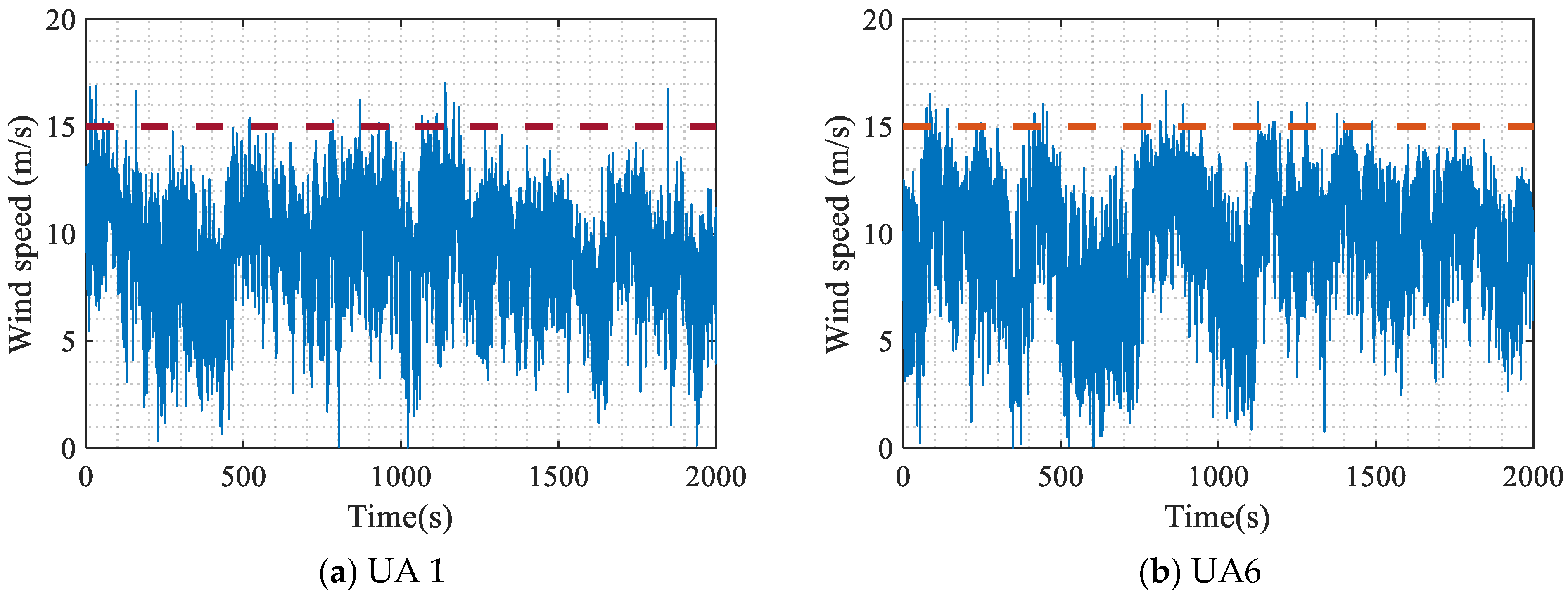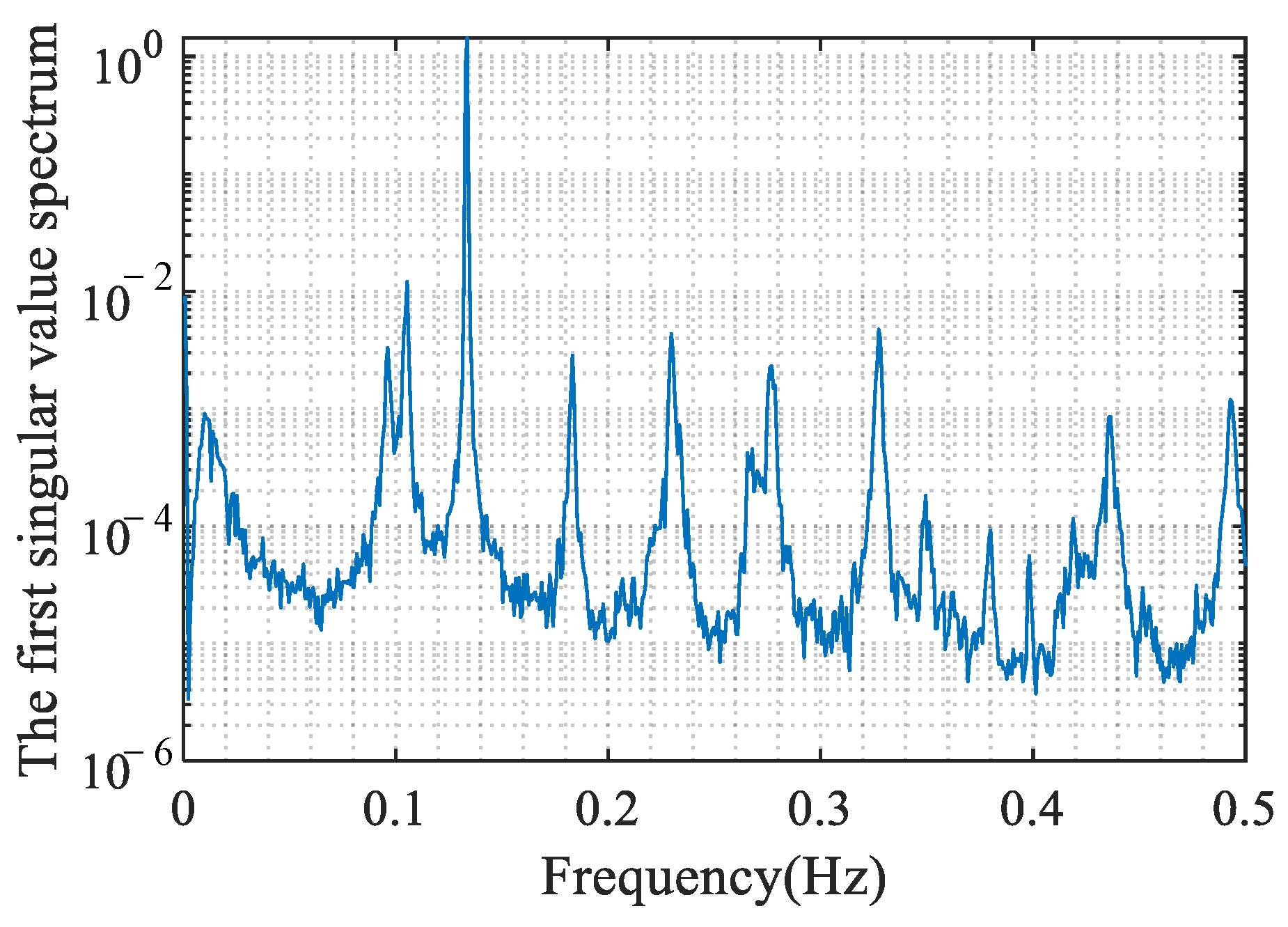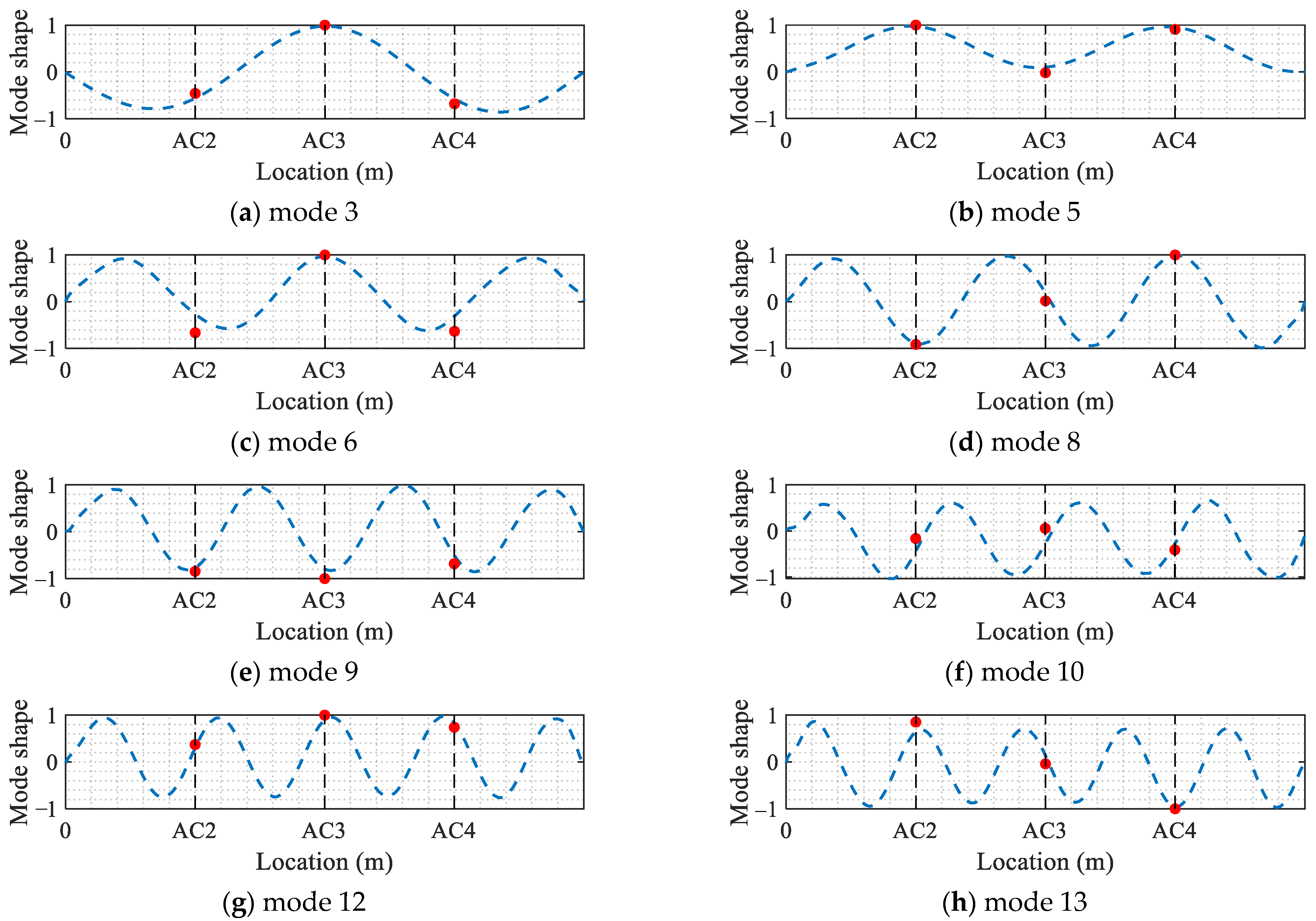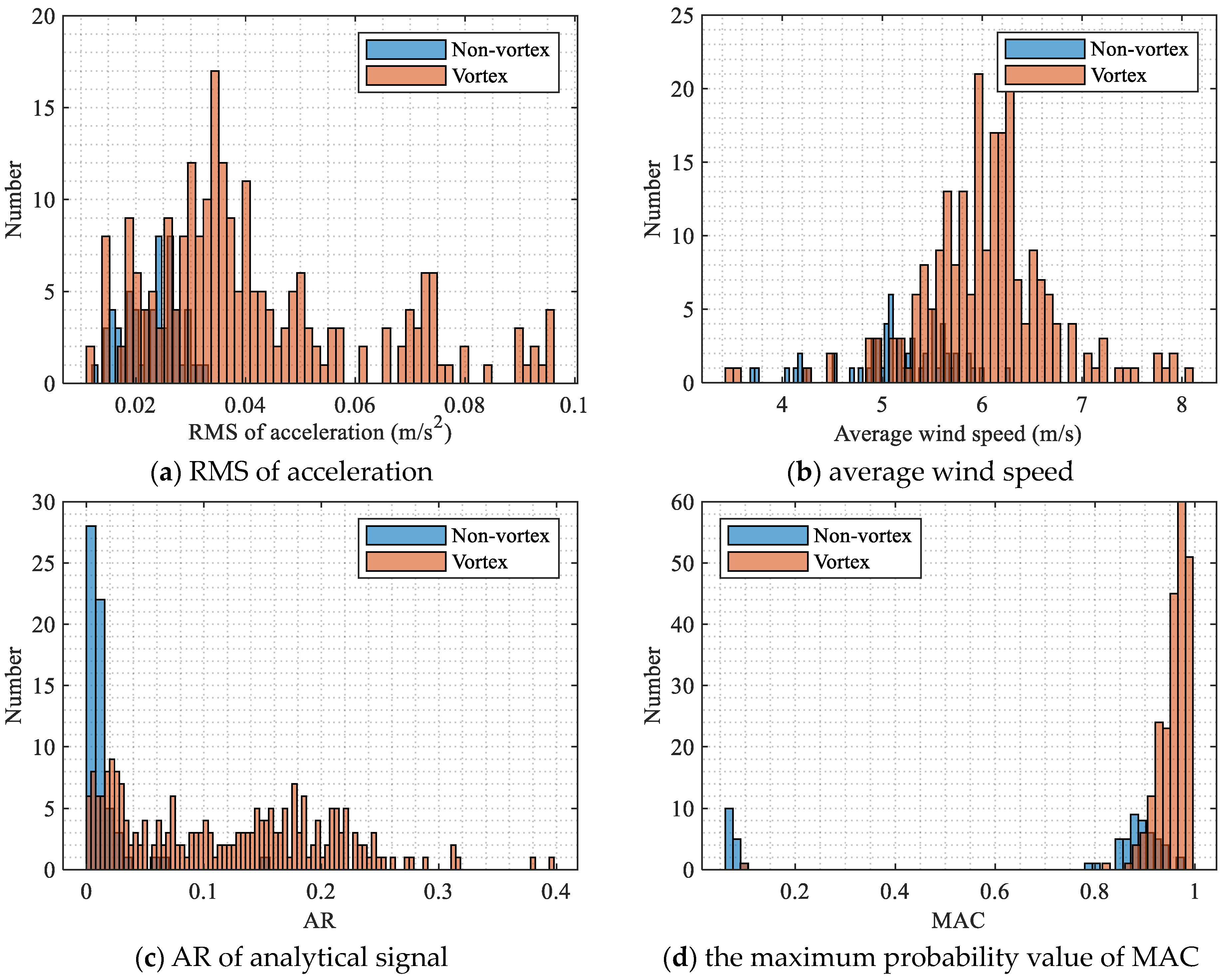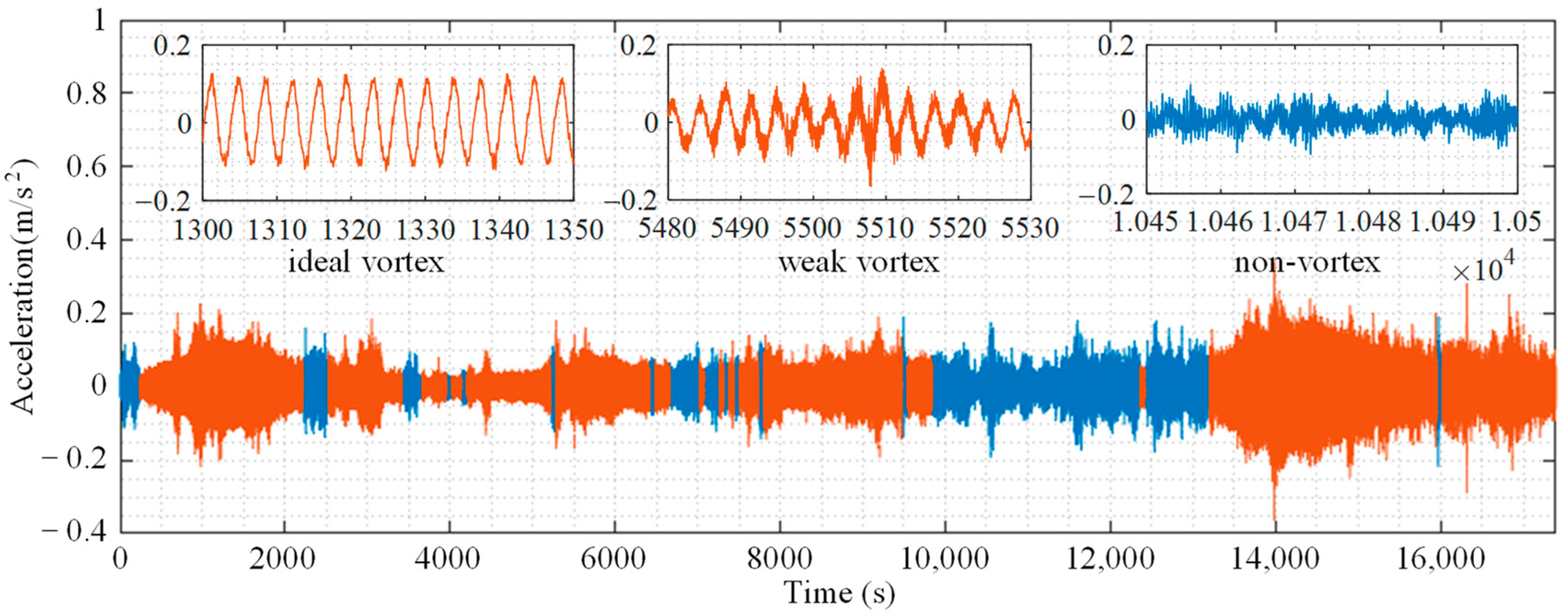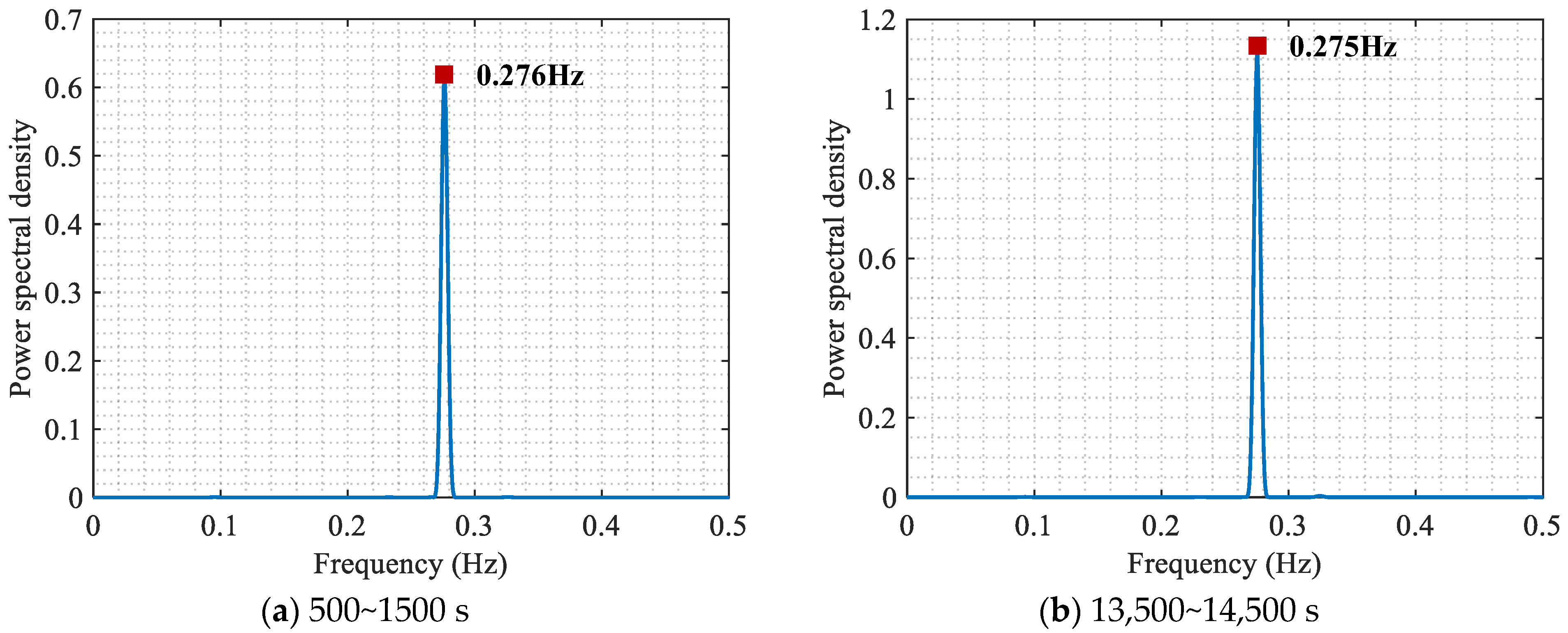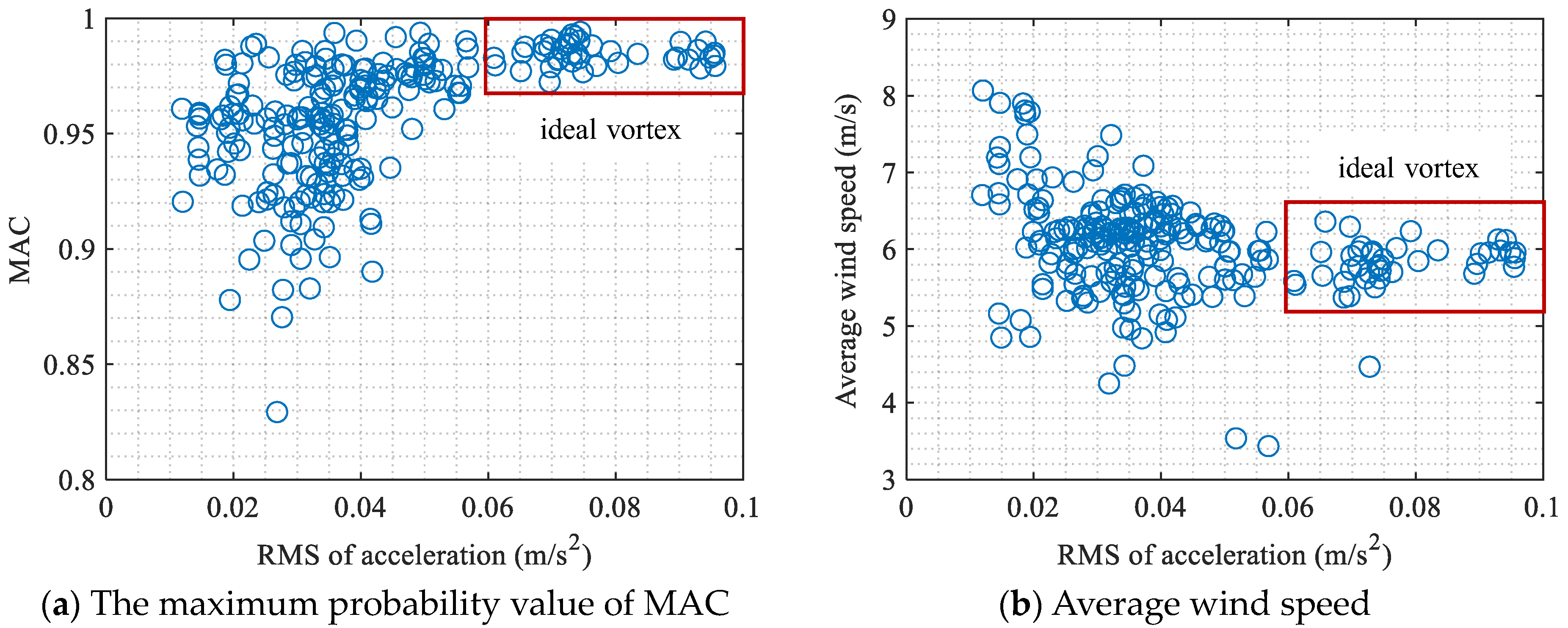1. Introduction
Due to the rising transportation needs in coastal areas, numerous sea-crossing bridges are either under construction or have already been built worldwide. In marine environments, the impact of extreme wind loads such as typhoons on bridges cannot be overlooked [
1]. Particularly, sea-crossing bridges often feature large spans and low stiffness. When extremely strong wind loads act on the bridge, significant vibrations occur. Vortex-induced vibration, which occurs at relatively low wind speeds, poses an important aerodynamic vibration concern for long-span sea-crossing bridges [
2,
3]. For example, the Great Belt suspension bridge encountered vortex-induced vibrations at moderate wind speeds ranging from approximately 5 to 10 m/s. The Trans-Tokyo Bay highway crossing bridge experienced its first-mode vortex-induced vibration at a wind speed of approximately 16–17 m/s [
4]. The vortex-induced vibration event typically involves significant amplitudes that can cause discomfort to drivers, and may even result in fatigue [
5] if the vortex-induced event persists over an extended period [
6]. Timely identification of vortex-induced vibrations and the prediction of their amplitudes are crucial for ensuring the safety of and comfort when using bridges [
7,
8,
9].
In recent years, research strategies for vortex-induced vibration have often involved methods [
10] based on wind tunnel testing [
11], computational fluid dynamics [
12], finite element modeling, and field monitoring. For instance, Govardhan and Williamson [
13] established the motion equation for the vortex-induced vibration system, taking into account the phase relationship between the vortex force and displacement. Duranay [
14,
15] examined the vortex formation modes at high Reynolds numbers using numerical and experimental techniques. The results illustrated that the vibration amplitudes are influenced by the mass ratio. In particular, there is a growing trend of installing structural health monitoring systems [
16,
17] on large-scale structures to monitor their on-site conditions. The large accumulation of field monitoring data establishes a robust basis for data-driven identification and the prediction of vortex-induced vibrations [
18,
19] of structures, including long-span bridges. For example, Zhang et al. [
20] developed a digital twin technique to simulate and predict the vortex-induced vibration of a long suspension bridge. In this technique, the bridge model was updated based on the monitored dynamic characteristics, and the vortex-induced force model was established using data from wind tunnel tests. Xu et al. [
21] established a prediction model for vortex-induced vibration based on big data, including vibration acceleration and wind data. The results showed that the identification rate of vortex-induced vibration could reach 89%. Given that vortex-induced vibration is a typical nonlinear fluid-structure interaction problem, a data-driven semi-empirical augmentation method has been developed by Gao et al. [
22] to improve the prediction of its nonlinear dynamic behaviors. Nevertheless, the general steps in data-driven prediction of vortex-induced vibrations include [
23]: accurately identifying the timing of vortex-induced vibration occurrences, developing a correlation model between vortex-induced vibration characteristics and environmental factors, and conducting amplitude prediction utilizing the correlation model between vortex-induced vibrations and environmental factors. Among them, automatically detecting the timing of vortex-induced vibration occurrences is crucial for successful vortex-induced vibration prediction [
24].
To automatically identify the vortex-induced vibration response from the extensive acceleration data, a method based on the random decrement technique is proposed [
25]. This method takes into account the single-mode free-decay characteristics of the random decrement function of vortex-induced vibration acceleration. Cao et al. [
26] utilized the root mean square (RMS) of acceleration and the energy concentration coefficient to assess the onset of vortex-induced vibration, and devised a five-level warning system for vortex-induced vibration events. Lim et al. [
27] introduced a classification method for vortex-induced vibration events using supervised learning techniques. Thirteen vortex-induced features, such as the RMS, maximum value, skewness, and kurtosis of acceleration, as well as the peak factor, mean wind velocity, and incident angle, were utilized in their study. Li et al. [
28] proposed a decision tree model to classify vortex-induced vibration modes, using wind speeds and directions relative to three measurement points as input data for the model. Guo et al. [
29] devised an identification and early-warning strategy for bridge vortex-induced vibration, analyzing wind characteristics and structural dynamic responses as the identification indices. However, the thresholds for these identification and early-warning indices need to be empirically determined. Moreover, the aforementioned vortex-induced vibration identification methods often can only determine the occurrence of vortex-induced vibration over a relatively long time scale. Over this longer time scale, ideal vortex-induced vibrations may not occur continuously. If all vibration data within this time scale, which includes some non-vortex-induced vibration events, are utilized for correlation analysis, it may lead to the establishment of an unreasonable correlation model between vortex-induced vibration and environmental factors, ultimately resulting in irrational predictions of vortex-induced vibration amplitudes. Therefore, it is necessary to develop a vortex-induced vibration event automatic identification method that is more refined in time scale and does not require empirical thresholds.
In this study, an almost real-time automatic identification method for vortex-induced vibrations in long-span bridges is introduced. Initially, the instantaneous classification indices for vortex-induced vibrations are derived from the vibration acceleration data of bridges. Subsequently, the vortex-induced indices are analyzed using fuzzy C-means clustering to achieve the automatic detection of vortex-induced vibration events without the need for thresholds. To guarantee the availability of identification and improve automation, the vortex-induced indices used in clustering are initially transformed into a standard normal distribution. Finally, the monitoring data from actual bridges is utilized to validate the feasibility of the classification framework. At the same time, results from the analysis of the correlation between environmental factors and acceleration amplitudes are provided to guide the prediction of vortex-induced vibration amplitudes.
2. Methodologies
In this section, the theoretical expression for bridge vortex-induced vibration is first briefly introduced. Furthermore, the indicators of a vortex-induced vibration feature are described. Finally, the classification method for the vortex-induced vibration mode is given.
2.1. Theoretical Expression of Vortex-Induced Vibration
Based on the modal superposition theory, the vibration signal of a bridge is composed of a set of modal responses:
where
represents the vibration signal of the bridge, the subscript
represents the measurement point,
represents time,
is the number of modes,
and
represent the mode shape and modal response.
The
modal response
in Equation (1) is an amplitude-modulated narrow-band signal, as follows:
where
is the
damped frequency of the bridge,
and
are the natural frequency and damping ratio of the bridge,
is the initial phase angle,
is the amplitude-modulated function that depends on the excitation characteristics.
When the vortex-induced vibration occurs, the vibration signal
of the bridge in Equation (1) is approximated as a single-mode amplitude-modulated signal, as follows:
where the amplitude-modulated function
depends on the phase bias between the vibration signal and the vortex shedding excitation [
30], expressed as follows:
where
is the initial amplitude,
,
and
are the amplitude, frequency and phase of the
th component contributed in
, respectively.
If the vortex-induced vibration related to the
mode occurs, vibration signals with respect to different measurement points are simultaneously written as Equation (5). It can be observed that the vortex-induced vibration signals at various measurement points are proportional, with the proportionality coefficient being the mode shape.
where
represents the number of measurement points.
2.2. Vortex-Induced Vibration Feature
Because vortex-induced vibrations typically manifest within specific ranges of wind loads, the wind speed and wind direction can serve as indicators for classifying such vibrations. In addition to assessing wind loads, vortex-induced vibrations can also be identified through the analysis of vibration signals from bridges. The bridge vibration-based classification indicators are described in the following. Moreover, a vortex-induced vibration signal and a non-vortex-induced vibration signal presented in
Figure 1 are used to explain the classification indicators that follow.
- (1)
Root mean square
The root mean square (RMS) of a vibration signal
is defined as:
The RMS is utilized to quantify the magnitude of vibration signals. In comparison to the non-vortex-induced vibration signals of a bridge subjected to normal wind loads, the vortex-induced vibration signals exhibit higher vibration magnitude. Therefore, the RMS of vibration signals can be used as an indicator to distinguish between vortex-induced and non-vortex-induced vibrations.
- (2)
Energy concentration factor
The energy concentration (EC) factor of the vibration signal
is defined as:
where
and
, respectively, represent the highest peak value and the second highest peak value on the power spectral density function curve
of the vibration signal
.
Taking the vibration signals presented in
Figure 1 as an example, the power spectral density functions related to vortex-induced vibration and non-vortex-induced vibration are displayed in
Figure 2. When the vortex-induced event occurs, only one mode significantly contributes to the vibration signal, resulting in the presence of a single prominent peak in its power spectral density function. This one-peak phenomenon does not appear in the power spectral density function of non-vortex-induced vibration signals. When only one peak significantly contributes to the power spectral density function, the energy concentration factor defined in Equation (7) becomes a small value, which can be utilized to detect vortex-induced vibration events.
- (3)
Amplitude ratio of analytical signal
Bridge vortex-induced vibration is usually a single-mode vibration, and its Hilbert transform carries a clear physical meaning. Through recursive Hilbert transform analysis of the bridge vibration signals, analytical signals are acquired. The real and imaginary components of the analytical signal are graphed, as illustrated in
Figure 3. When vortex-induced vibration is present, the real-imaginary plot of the analytical signal displays circular features, as depicted in
Figure 3a, referred to as the vortex-induced vibration circle. On the other hand, in cases of non-vortex-induced vibration, the real-imaginary plot appears disorderly, as shown in
Figure 3b.
To quantify whether the real-imaginary components of the analytical have become a vortex-induced vibration circle, the amplitude ratio (AR) of the analytical signal defined in Equation (8) is used. The amplitude ratio ranges from 0 to 1, where a higher AR value signifies the presence of a distinct vortex-induced vibration circle.
where
is the imaginary unit,
represents the modulus operator,
represents the Hilbert transform of the vibration signal
, as follows:
- (4)
Modal assurance criterion
According to the vortex-induced vibration expression in Equation (5), it is obvious that the vibration shape vector
is proportional to the mode shape vector
, with the proportional coefficient as
. However, the proportional characteristics mentioned above cannot be observed in the non-vortex-induced vibration responses of a bridge under normal wind loads, as multiple modes contribute to the vibration signals. Therefore, this proportional relation between the vibration shape vector
and the mode shape vector
can be used for finding the vortex-induced events. When the modal response
, the modal assurance criterion (MAC) in Equation (10) can be used to quantify this proportional relation. The MAC ranges from 0 to 1, with a higher MAC value indicating a stronger proportionality between the two vectors.
2.3. Fuzzy C-Means Clustering Algorithm
The fuzzy C-means clustering is a widely used unsupervised learning algorithm that partitions data points into different clusters, ensuring that data points within the same cluster exhibit higher similarity to each other, while those from different clusters display lower similarity to each other. The term C represents the number of clusters.
Given a data point with its feature as
, the fuzzy C-means clustering method can classify it into a cluster
by minimizing the following function:
where
denotes the cluster number,
denotes the total number of data points,
denotes the Euclidean norm,
is the center of the cluster
,
denotes the membership of data point
to the cluster
, the superscript
denotes the fuzzy coefficient and is commonly set as 2.
The clustering process can be conducted as follows. First, the center
of each cluster
is initialized. Second, the membership
is updated through Equation (12). Third, the objective function in Equation (11) is calculated. Four, the center of each cluster is updated through Equation (13). The above process was repeated until the objective function in Equation (11) was minimized. Finally, the data point
with its feature
is classified into the cluster
if the membership
is greater than the memberships
for
and
.
2.4. Vortex-Induced Vibration Classification Framework
The issues that the vortex-induced vibration classification framework aims to address include two stages: the first stage is to determine whether a vortex-induced vibration event occurs, and the second stage is to determine which vibration mode the vortex-induced vibration event belongs to.
The first stage involves using the fuzzy C-means clustering method to classify the current vibration measurements as either belonging to the vortex-induced vibration cluster or the non-vortex-induced vibration cluster. As detailed in
Section 2.3, the fuzzy C-means clustering algorithm requires three pre-set parameters. The first parameter is the number of clusters, which, in this case, is set to 2 to distinguish solely between vortex-induced vibration and non-vortex-induced vibration.
The second parameter is the feature vector
of a data point, which should consist of indicators that can differentiate between vortex-induced vibration and non-vortex-induced vibration. To well define the occurrence timing of vortex-induced vibration and non-vortex-induced vibration on a time scale, it is necessary to select certain vortex-induced vibration feature indicators that can be computed solely using short-time or instantaneous data. Among the feature indicators listed in
Section 2.2, the wind speed, the RMS, the AR of the analytical signal, and the MAC can be calculated using short-time measurement data, and these are considered to construct the feature vector
. In this study, the short-time resolution used for detecting vortex-induced vibrations is selected as one minute. In this case, the average wind speed, the RMS of vibration data, the AR of the analytical signal, and the maximum probability of MAC within one minute, are calculated to construct the initial feature vector
of the vibration within this minute, where
represents the
datapoint (i.e., the
minute). Based on the feature indicators described in
Section 2.2, the range of variation for each feature indicator is distinct. For instance, the range of variation for MAC and the amplitude falls between 0 and 1, whereas the ranges for the RMS of the vibration signal and wind speed do not lie within this range. To prevent any single feature indicator from unduly impacting the clustering results, it should not directly use the initial feature vectors for clustering. Instead, it is necessary to subject each feature in the initial feature vector
to a standard normal distribution transformation. Subsequently, the transformed feature vector
is used for clustering, where
to
are respectively transformed from
to
. After undergoing standard normal distribution transformation, the standard deviation of each feature becomes 1.
The third parameter is the initial center of the cluster with and . In this study, the initial center is set according to the standard deviations of features. In detail, and . Except for the average wind speed feature, other features (the RMS of the vibration signal, the AR of the analytical signal, and the maximum probability of MAC after standard normal distribution transformation) exhibit a characteristic where the likelihood of a vortex-induced event occurring increases with higher feature values. Therefore, the cluster with the initial center is more likely associated with the vortex-induced vibration cluster. After the fuzzy C-means clustering, the time periods associated with vortex-induced vibration from those associated with non-vortex-induced vibration can be distinguished.
Once the occurrence of vortex-induced vibration has been detected, the next stage involves determining the specific mode to which the vortex-induced vibration belongs. First, the vortex-induced vibration signals are transformed into frequency domain, where the auto power spectral density functions are obtained. the vortex-induced vibration signals are converted into the frequency domain, resulting in the acquisition of auto power spectral density functions. Subsequently, the highest peak in the auto power spectral density function is identified, similar to that in
Figure 2a. The frequency associated with the highest peak is linked to the vortex-induced vibration mode. The flowchart is given in
Figure 4.
4. Conclusions
This study presents an unsupervised classification method for identifying the moments when vortex-induced vibration occurs, which is essential for constructing correlation models used in the early-warning of bridge vortex-induced performance.
To reliably determine the occurrence moments of vortex-induced vibration, a combination of short-term and nearly instantaneous vortex-induced vibration indicators are employed, including the average wind speed, the RMS of vibration data, the AR of the analytical signal, and the maximum probability of MAC.
The fuzzy C-means clustering is employed to automatically detect vortex-induced vibration, without the need to set threshold values for the vibration indicators. In this approach, the number of clusters is automatically set to 2. Additionally, to address unequal contributions from different indicators, the clustering indicators actually utilize the calculated values of vortex-induced vibration indicators transformed by normal distribution.
Analyzing the monitoring data of actual bridges, it was found that the ideal vortex-induced vibration does not continuously occur over a long period of time. The correlation between non-vortex-induced vibration amplitude and environmental factors exhibits a completely different trend compared to the correlation between vortex-induced vibration amplitude and environmental factors.
Nevertheless, due to limitations in the monitoring data, only four indicators have been applied to identify vortex-induced vibration. In fact, other information such as wind direction angle is also an important basis for accurately distinguishing vortex-induced vibration. If the monitoring data allows, more wind field characteristics should be applied in the future.

